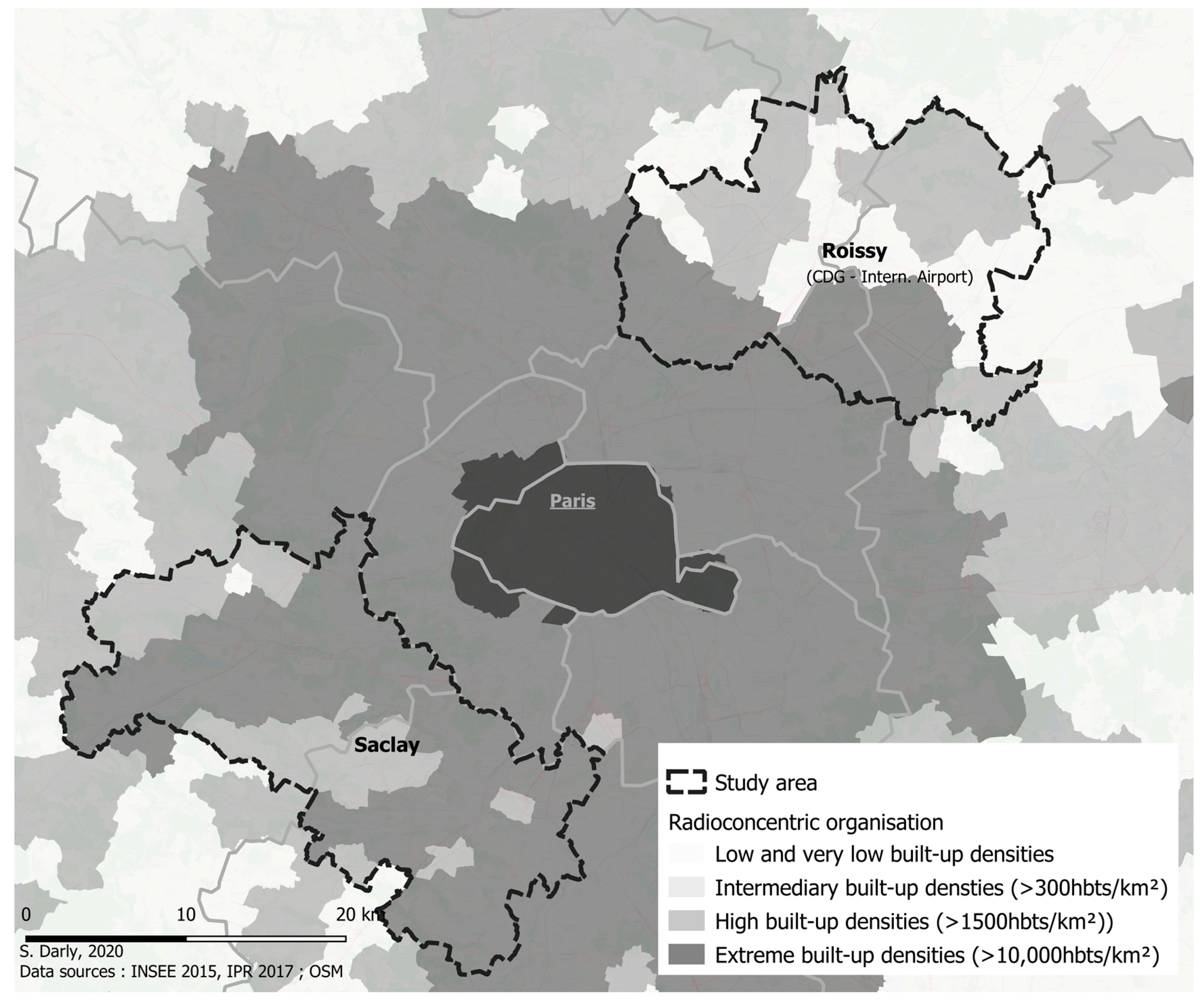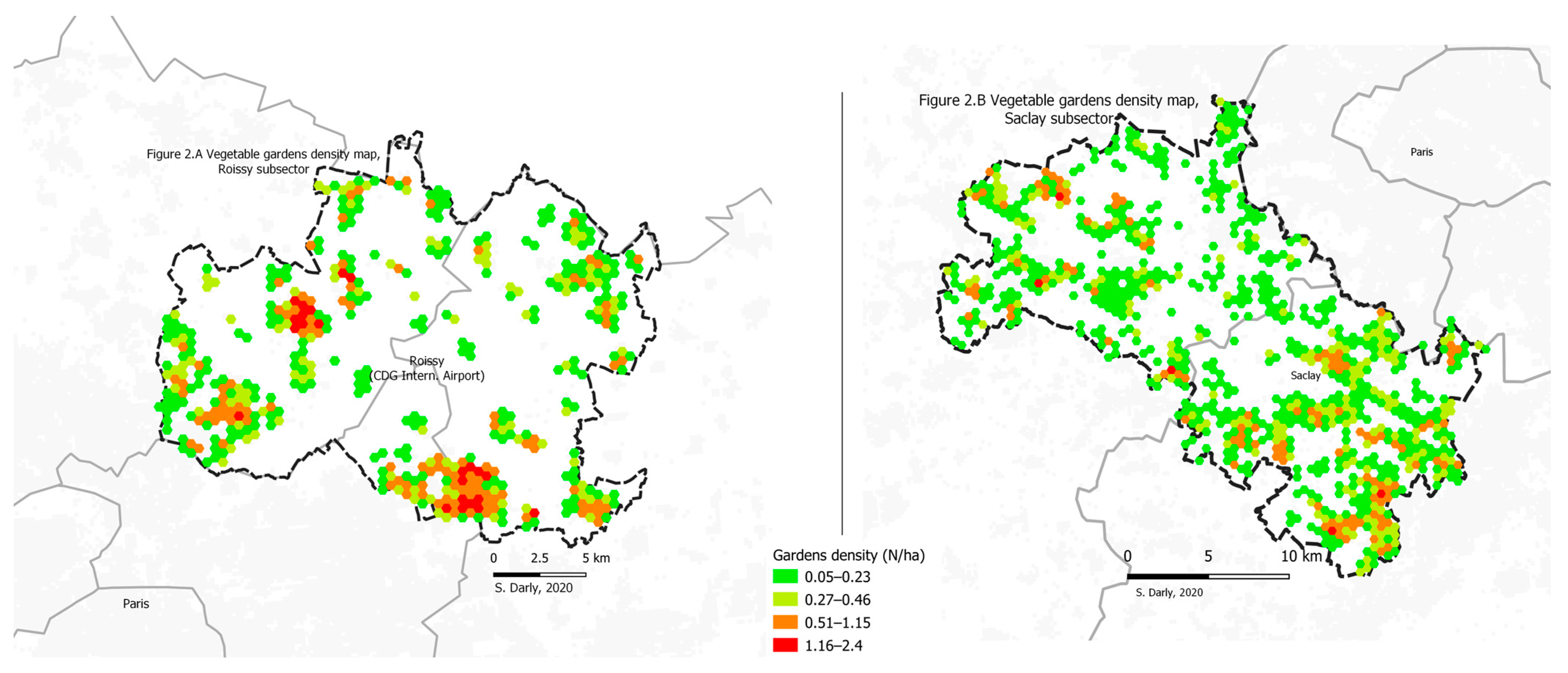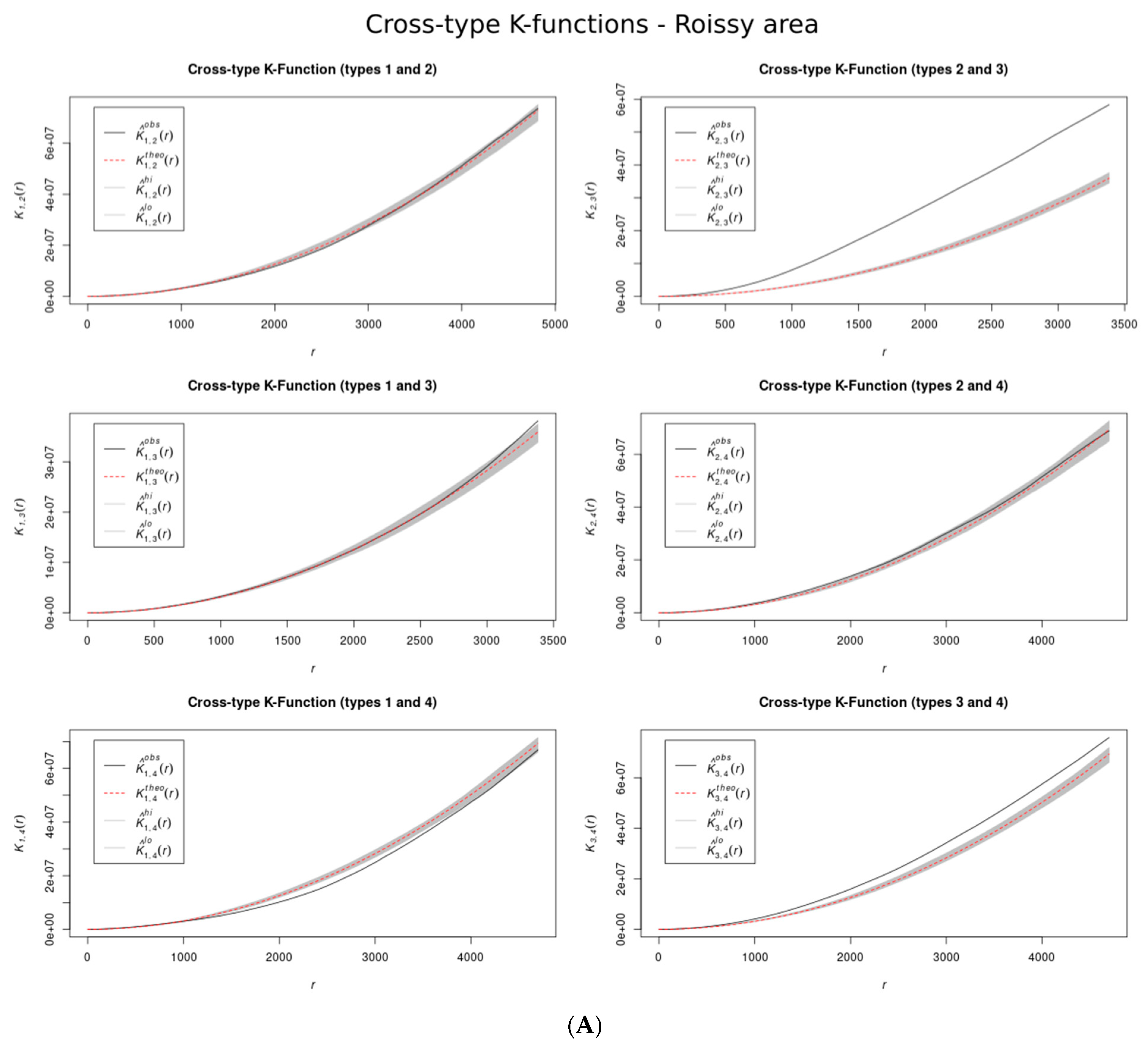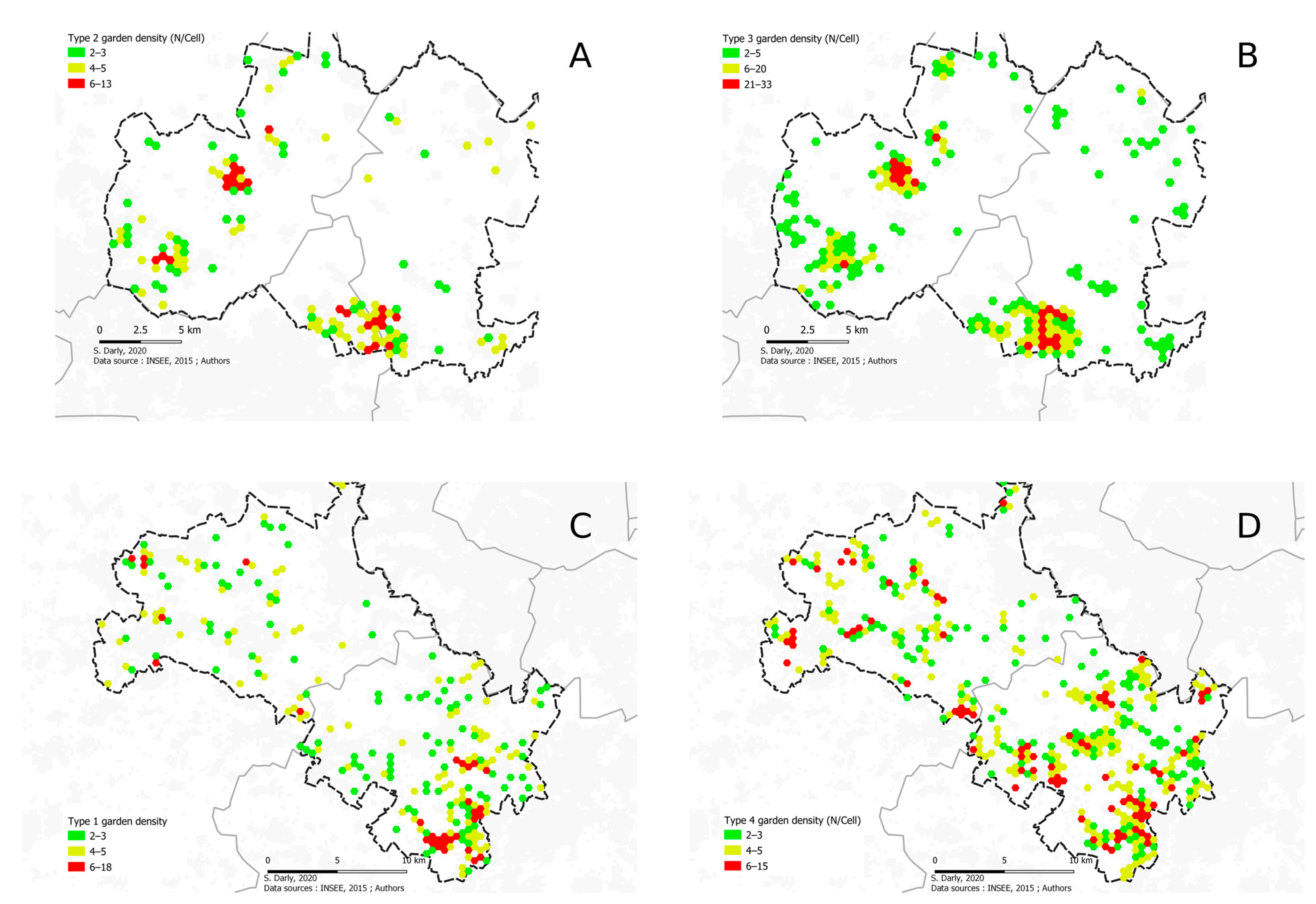Home Gardening and the Social Divide of Suburban Space: Methodological Proposal for the Spatial Analysis of a Social Practice in the Greater Paris Urban Area
Abstract
1. Introduction
2. Materials and Methods
2.1. Study Area
2.2. Mapping Home Kitchen Gardens
2.2.1. Spatial Indicator of Food Related Motivations and Residential Profiles of Gardeners
2.2.2. Covariates
2.3. Data Spatial Analyses
2.3.1. Exploring the Spatial Patterning of Gardens Using the Ripley’s K-Function
2.3.2. Modelling the Association between Garden Intensity and Spatial Covariates
3. Results
3.1. Overall Geographical Description
3.1.1. Micro-Spatial Patterns and Typology
3.1.2. Inter-Sectors Spatial Distribution
3.1.3. Intra-Sector Spatial Distribution
3.2. Descriptive Statistics on Garden Spatial Patterning
3.3. Cox process Models with Spatial Covariates
4. Discussion
5. Conclusions
Supplementary Materials
Author Contributions
Funding
Institutional Review Board Statement
Informed Consent Statement
Data Availability Statement
Acknowledgments
Conflicts of Interest
References
- Smit, J.; Nasr, J.; Ratta, A. Urban Agriculture: Food, Jobs and Sustainable Cities; United Nations Development Programme: New York, NY, USA, 1996; p. 332. [Google Scholar]
- Zezza, A.; Tasciotti, L. Urban Agriculture, Poverty, and Food Security: Empirical Evidence from a Sample of Developing Countries. Food Policy 2010, 35, 265–273. [Google Scholar] [CrossRef]
- Orsini, F.; Kahane, R.; Nono-Womdim, R.; Gianquinto, G. Urban Agriculture in the Developing World: A Review. Agron. Sustain. Dev. 2013, 33, 695–720. [Google Scholar] [CrossRef]
- Viljoen, A.; Bohn, K. Second Nature Urban Agriculture: Designing Productive Cities, Ten Years on from the Continuous Productive Urban Landscape (CPUL City) Concept; Routledge: Abington, UK, 2014; ISBN 978-1-317-67451-1. [Google Scholar]
- Chou, S.S. Agrarianism in the City: Urban Agriculture and the Anthropocene Futurity. Concentric Lit. Cult. Stud. 2017, 43, 51–69. [Google Scholar]
- Lohrberg, F.; Lička, L.; Scazzosi, L.; Timpe, A. (Eds.) Urban Agriculture Europe; Jovis: Berlin, Germany, 2016; ISBN 978-3-86859-371-6. [Google Scholar]
- Azunre, G.A.; Amponsah, O.; Peprah, C.; Takyi, S.A.; Braimah, I. A Review of the Role of Urban Agriculture in the Sustainable City Discourse. Cities 2019, 93, 104–119. [Google Scholar] [CrossRef]
- Certomà, C.; Tornaghi, C. Political Gardening. Transforming Cities and Political Agency. Local Environ. 2015, 20, 1123–1131. [Google Scholar] [CrossRef]
- Paddeu, F. From One Movement to Another? Comparing Environmental Justice Activism and Food Justice Alternative Practices; Justice Spatiale/Spatial Justice 2016, n°9. Available online: https://www.jssj.org/article/dun-mouvement-a-lautre-des-luttes-contestataires-de-justice-environnementale-aux-pratiques-alternatives-de-justice-alimentaire/ (accessed on 11 March 2021).
- Horst, M.; McClintock, N.; Hoey, L. The Intersection of Planning, Urban Agriculture, and Food Justice: A Review of the Literature. J. Am. Plan. Assoc. 2017, 83, 277–295. [Google Scholar] [CrossRef]
- Colasanti, K. Assessing the Local Food Supply Capacity of Detroit, Michigan. JAFSCD 2010, 41–58. [Google Scholar] [CrossRef]
- Kremer, P.; DeLiberty, T.L. Local Food Practices and Growing Potential: Mapping the Case of Philadelphia. Appl. Geogr. 2011, 31, 1252–1261. [Google Scholar] [CrossRef]
- McClintock, N.; Cooper, J.; Khandeshi, S. Assessing the Potential Contribution of Vacant Land to Urban Vegetable Production and Consumption in Oakland, California. Landsc. Urban Plan. 2013, 111, 46–58. [Google Scholar] [CrossRef]
- Haberman, D.; Gillies, L.; Canter, A.; Rinner, V.; Pancrazi, L.; Martellozzo, F. The Potential of Urban Agriculture in Montréal: A Quantitative Assessment. ISPRS Int. J. Geo-Inf. 2014, 3, 1101–1117. [Google Scholar] [CrossRef]
- Orsini, F.; Gasperi, D.; Marchetti, L.; Piovene, C.; Draghetti, S.; Ramazzotti, S.; Bazzocchi, G.; Gianquinto, G. Exploring the Production Capacity of Rooftop Gardens (RTGs) in Urban Agriculture: The Potential Impact on Food and Nutrition Security, Biodiversity and Other Ecosystem Services in the City of Bologna. Food Secur. 2014, 6, 781–792. [Google Scholar] [CrossRef]
- Saha, M.; Eckelman, M.J. Growing Fresh Fruits and Vegetables in an Urban Landscape: A Geospatial Assessment of Ground Level and Rooftop Urban Agriculture Potential in Boston, USA. Landsc. Urban Plan. 2017, 165, 130–141. [Google Scholar] [CrossRef]
- Clinton, N.; Stuhlmacher, M.; Miles, A.; Uludere Aragon, N.; Wagner, M.; Georgescu, M.; Herwig, C.; Gong, P. A Global Geospatial Ecosystem Services Estimate of Urban Agriculture. Earth’s Future 2018, 6, 40–60. [Google Scholar] [CrossRef]
- Mok, H.-F.; Williamson, V.G.; Grove, J.R.; Burry, K.; Barker, S.F.; Hamilton, A.J. Strawberry Fields Forever? Urban Agriculture in Developed Countries: A Review. Agron. Sustain. Dev. 2014, 34, 21–43. [Google Scholar] [CrossRef]
- Certomà, C.; Martellozzo, F. Cultivating Urban Justice? A Spatial Exploration of Urban Gardening Crossing Spatial and Environmental Injustice Conditions. Appl. Geogr. 2019, 106, 60–70. [Google Scholar] [CrossRef]
- Taylor, J.R.; Lovell, S.T. Urban Home Food Gardens in the Global North: Research Traditions and Future Directions. Agric. Hum. Values 2014, 31, 285–305. [Google Scholar] [CrossRef]
- National Gardening Association, Special Report: Garden to Table, A 5-Year Look at Food Gardening in America. 2014. Available online: https://garden.org/special/pdf/2014-NGA-Garden-to-Table.pdf (accessed on 11 March 2021).
- Comstock, N.; Miriam Dickinson, L.; Marshall, J.A.; Soobader, M.-J.; Turbin, M.S.; Buchenau, M.; Litt, J.S. Neighborhood Attachment and Its Correlates: Exploring Neighborhood Conditions, Collective Efficacy, and Gardening. J. Environ. Psychol. 2010, 30, 435–442. [Google Scholar] [CrossRef]
- Schupp, J.L.; Sharp, J.S. Exploring the Social Bases of Home Gardening. Agric. Hum. Values 2012, 29, 93–105. [Google Scholar] [CrossRef]
- City Farmers. 44% of Vancouver Households Grow Food Says City Farmer. 2002. Available online: https://www.cityfarmer.org/44percent.html (accessed on 11 March 2021).
- Ville de Montréal. Agriculture Urbaine: Sondage Auprès de La Population de l’île de Montréal. 2013. Available online: https://ville.montreal.qc.ca/pls/portal/docs/PAGE/CHANTIER_DEMOCRATIE_FR/MEDIA/DOCUMENTS/agriculture_urbaine_sommaire_executif_05092013.pdf (accessed on 11 March 2021).
- Vávra, J.; Megyesi, B.; Duží, B.; Craig, T.; Klufová, R.; Lapka, M.; Cudlínová, E. Food Self-Provisioning in Europe: An Exploration of Sociodemographic Factors in Five Regions: Food Self-Provisioning in Europe. Rural Sociol. 2018, 83, 431–461. [Google Scholar] [CrossRef]
- Grange, D.; Vincelet, C. Comportements d’achats Alimentaires En Ile-de-France. In Baromètre Santé Nutrition 2008; Observatoire régional de santé: Paris, France, 2010; Available online: https://www.ors-idf.org/fileadmin/DataStorageKit/ORS/Etudes/2010/Etude2010_3/Comportements_achats_IdF_1_.pdf (accessed on 11 March 2021).
- Marie, M. Estimation de La Contribution de La Production Potagère Domestique Au Système Alimentaire Local: Enseignements à Partir de l’étude Des Cas de Rennes, Caen et Alençon. Vertigo 2019. [Google Scholar] [CrossRef]
- McClintock, N.; Mahmoudi, D.; Simpson, M.; Santos, J.P. Socio-Spatial Differentiation in the Sustainable City: A Mixed-Methods Assessment of Residential Gardens in Metropolitan Portland, Oregon, USA. Landsc. Urban Plan. 2016, 148, 1–16. [Google Scholar] [CrossRef]
- Taylor, J.R.; Lovell, S.T. Mapping Public and Private Spaces of Urban Agriculture in Chicago through the Analysis of High-Resolution Aerial Images in Google Earth. Landsc. Urban Plan. 2012, 108, 57–70. [Google Scholar] [CrossRef]
- Pulighe, G.; Lupia, F. Mapping Spatial Patterns of Urban Agriculture in Rome (Italy) Using Google Earth and Web-Mapping Services. Land Use Policy 2016, 59, 49–58. [Google Scholar] [CrossRef]
- Duchemin, E. L’apport Alimentaire de l’agriculture Urbaine Sociale aux Villes en Temps de Crise: Le cas de Montréal; AgriUrbain: 2020. Available online: https://agriurbain.hypotheses.org/4739 (accessed on 11 March 2021).
- European Commission; Statistical Office of the European Union. Urban Europe: Statistics on Cities, Towns and Suburbs: 2016 Edition; Publications Office of the European Union: Luxembourg, 2016; p. 282. [Google Scholar]
- Pistre, P.; Richard, F. Seulement 5 ou 15 % de Ruraux en France Métropolitaine? Les Malentendus du Zonage en Aires Urbaines; Géoconfluences. 2018. Available online: http://geoconfluences.ens-lyon.fr/informations-scientifiques/dossiers-regionaux/france-espaces-ruraux-periurbains/articles-scientifiques/definition-espace-rural-france (accessed on 11 March 2021).
- Valles, V. Entre 2011 et 2016, Les Grandes Aires Urbaines Portent La Croissance Démographique Française. 2018. Available online: https://www.insee.fr/fr/statistiques/3682672 (accessed on 11 March 2021).
- Mischi, J.; Renahy, N.; Diallo, A. Les classes populaires en milieu rural. In Campagnes Contemporaines; Editions Quæ: Versailles, France, 2016; p. 23. ISBN 978-2-7592-2515-6. [Google Scholar]
- Tous Au Vert? Scénario Rétro-Prospectif d’un Exode Urbain. Available online: https://theconversation.com/tous-au-vert-scenario-retro-prospectif-dun-exode-urbain-137800 (accessed on 12 March 2021).
- Berque, A.; Bonnin, P.; Ghorra-Gobin, C. La ville insoutenable; Belin: Paris, France, 2006; p. 366. [Google Scholar]
- Adelfio, M. Socially Sustainable Suburbia: Addressing a Puzzling and Multifaceted Issue. Articulo J. Urban Res. 2016. [Google Scholar] [CrossRef]
- Bourdieu, P. Habitus. In Habitus: A Sense of Place; Routledge: Abington, UK, 2017; pp. 59–66. [Google Scholar]
- Dubost, F. La Scarole et Le Bégonia. Les Nouveaux Usages du Jardin. Ethnol. Française 1979, 9, 365–376. [Google Scholar]
- Czegledy, A. Urban Peasants in a Post-Socialist World: Small-Scale Agriculturalists in Hungary. In Post-Socialist Peasant? Leonard, P., Kaneff, D., Eds.; Palgrave Macmillan UK: London, UK, 2002; pp. 200–220. ISBN 978-1-349-41979-1. [Google Scholar]
- Pourias, J.; Aubry, C.; Duchemin, E. Is Food a Motivation for Urban Gardeners? Multifunctionality and the Relative Importance of the Food Function in Urban Collective Gardens of Paris and Montreal. Agric. Hum. Values 2016, 33, 257–273. [Google Scholar] [CrossRef]
- Smith, J.; Jehlička, P. Quiet Sustainability: Fertile Lessons from Europe’s Productive Gardeners. J. Rural Stud. 2013, 32, 148–157. [Google Scholar] [CrossRef]
- Jehlička, P.; Daněk, P. Rendering the Actually Existing Sharing Economy Visible: Home-Grown Food and the Pleasure of Sharing: Home-Grown Food and the Pleasure of Sharing. Sociol. Rural. 2017, 57, 274–296. [Google Scholar] [CrossRef]
- Kortright, R.; Wakefield, S. Edible Backyards: A Qualitative Study of Household Food Growing and Its Contributions to Food Security. Agric. Hum. Values 2011, 28, 39–53. [Google Scholar] [CrossRef]
- Mestdagh, L. Jardiner Entre Soi; Éditions L’Harmattan: Paris, France, 2018; p. 306. ISBN 978-2-14-005510-2. [Google Scholar]
- McClintock, N. Cultivating (a) Sustainability Capital: Urban Agriculture, Ecogentrification, and the Uneven Valorization of Social Reproduction. Ann. Am. Assoc. Geogr. 2018, 108, 579–590. [Google Scholar] [CrossRef]
- Krueger, R.; Agyeman, J. Sustainability Schizophrenia or “Actually Existing Sustainabilities?” Toward a Broader Understanding of the Politics and Promise of Local Sustainability in the US. Geoforum 2005, 36, 410–417. [Google Scholar] [CrossRef]
- Burgin, S. Sustainability as a Motive for Leisure-Time Gardening: A View from the ‘Veggie Patch’. Int. J. Environ. Stud. 2018, 75, 1000–1010. [Google Scholar] [CrossRef]
- Ančić, B.; Domazet, M.; Župarić-Iljić, D. “For My Health and for My Friends”: Exploring Motivation, Sharing, Environmentalism, Resilience and Class Structure of Food Self-Provisioning. Geoforum 2019, 106, 68–77. [Google Scholar] [CrossRef]
- Teitelbaum, S.; Beckley, T.M. Hunted, Harvested and Homegrown: The Prevalence of Self-Provisioning in Rural Canada. J. Rural Community Dev. 2006, 1, 114–130. [Google Scholar]
- Clerval, A.; Delage, M. La métropole parisienne: Une mosaïque sociale de plus en plus différenciée. Métropolitiques. 2014. Available online: https://metropolitiques.eu/La-metropole-parisienne-une.html (accessed on 11 March 2021).
- Ribardière, A. Les Territoires Populaires Du Grand Paris. Métropolitiques. 2019. Available online: https://metropolitiques.eu/Les-territoires-populaires-du-Grand-Paris.html (accessed on 11 March 2021).
- Pourias, J.; Daniel, A.-C.; Aubry, C. La fonction alimentaire des jardins associatifs urbains en question. Pour 2012, 215–216, 333. [Google Scholar] [CrossRef]
- Pourias, J.; Duchemin, E.; Aubry, C. Products from Urban Collectiv e Gardens: Food for Thought or for Consumption? Insights from Paris and Montreal. JAFSCD 2015, 1–25. [Google Scholar] [CrossRef]
- Sovová, L. Self-Provisioning, Sustainability and Environmental Consciousness in Brno Allotment Gardens. SS 2015, 12, 11–26. [Google Scholar] [CrossRef]
- Institut National de la Recherche Agronomique (France). Les Fruits et Légumes dans L’alimentation: Enjeux et Déterminants de la Consommation; Éd. Quae: Versailles, Germany, 2008; ISBN 978-2-7592-0083-2. [Google Scholar]
- Schwartz, C. Jardins Potagers: Terres Inconnues? EDP Sciences: Les Ulis, France, 2013; ISBN 978-2-7598-1037-6. [Google Scholar]
- Brunsdon, C.; Comber, L. An Introduction to R for Spatial Analysis and Mapping; SAGE: London, UK, 2014; ISBN 978-1-4739-1120-8. [Google Scholar]
- Ripley, B.D. The Second-Order Analysis of Stationary Point Processes. J. Appl. Probab. 1976. [Google Scholar] [CrossRef]
- Baddeley, A.; Rubak, E.; Turner, R. Spatial Point Patterns: Methodology and Applications with R; Chapman and Hall/CRC: Boca Raton, FL, USA; London, UK; New York, NY, USA, 2015; ISBN 978-1-4822-1020-0. [Google Scholar]
- Lotwick, H.W.; Silverman, B.W. Methods for Analysing Spatial Processes of Several Types of Points. J. R. Stat. Soc. Ser. B (Methodological) 1982, 44, 406–413. [Google Scholar] [CrossRef]
- Espinosa Seguí, A.; Maćkiewicz, B.; Rosol, M. From Leisure to Necessity: Urban Allotments in Alicante Province, Spain, in Times of Crisis. Int. J. Crit. Geogr. 2017, 16, 276–304. [Google Scholar]
- Guitart, D.; Pickering, C.; Byrne, J. Past Results and Future Directions in Urban Community Gardens Research. Urban For. Urban Green. 2012, 11, 364–373. [Google Scholar] [CrossRef]
- Kimber, C.T. Gardens and Dwelling: People in Vernacular Gardens. Geogr. Rev. 2004, 94, 263–283. [Google Scholar] [CrossRef]
- Lope-Alzina, D.G. A Conceptual Approach to Unveil Traditional Homegardens as Fields of Social Practice. Ethnobiol. Conserv. 2017. [Google Scholar] [CrossRef]
- Moulaert, F.; Rodríguez, A.; Swyngedouw, E. The Globalized City: Economic Restructuring and Social Polarization in European Cities; Oxford Geographical and Environmental Studies Series; Oxford University Press: Oxford, UK; New York, NY, USA, 2003; ISBN 978-0-19-926040-9. [Google Scholar]





| Pop. (households) | Single House Households/All Households | House Owners/All Households | |
|---|---|---|---|
| Île-de-France region | 11,987,500 (4,875,580) | 27.90% | 47.80% |
| Roissy subsector | 432,769 (143,639) | 47.11% | 53.40% |
| Saclay subsector | 804,445 (317,265) | 34.02% | 55.85% |
| Urbanicity Profile | Urban (High Built Area Densities) | Intermediate (Interm. Built Area Densities) | Rural (Low Built Area Densities) | |||
|---|---|---|---|---|---|---|
| Municip. | Households | Municip. | Households | Municip. | Households | |
| Pool Sample | 51 | 378,617 | 33 | 77,224 | 17 | 5063 |
| Roissy subsector | 11 | 98,976 | 17 | 39,638 | 16 | 5025 |
| Saclay subsector | 40 | 279,641 | 16 | 37,586 | 1 | 38 |
| Classification Thresholds | Lowest Value | First Quartile | Median Value | Third Quartile | Highest Value |
|---|---|---|---|---|---|
| Pool | 9806 | 22,737 | 27,496 | 33,256 | 58,481 |
| Roissy | 10,268 | 19,346 | 22,620 | 25,582 | 44,388 |
| Saclay | 9806 | 25,993 | 30,570 | 35,544 | 58,481 |
| Tax plots with VHG | Houses with VHG as % of Single Houses (Estimated) | VHG Total Area | Median Area | M2 of VHG/Households | Total Area of Allotment Gardens | |
|---|---|---|---|---|---|---|
| Total | 7792 | 4.00% * | 81.42 ha | 72 m2 | 1.7 | 98 ha |
| North/Roissy | 3591 | 5.20% * | 40.23 ha | 79 m2 | 2.7 | 53 ha |
| South/Saclay | 4201 | 3.34% * | 41.19 ha | 62 m2 | 1.3 | 55 ha |
| N Tax Plots (% of Sector Total VHG) | Total Area | Median VHG Size | Ratio Food/Garden | |
|---|---|---|---|---|
| Type 1 profile—largeholder food provider | ||||
| Total | 1765 (22.5%) | 42.54 ha (52.3%) | 184 m2 | 26% |
| North/Roissy | 798 (22%) | 19.08 ha (23.4%) | 188 m2 | 30% |
| South/Saclay | 967 (22%) | 23.45 ha (28.8%) | 180 m2 | 24.00% |
| Type 2 profile—smallholder food provider | ||||
| Total | 765 (10%) | 11.50 ha (14.1%) | 139 m2 | 50% |
| North/Roissy | 554 (15.5%) | 8.40 ha (10.3%) | 140 m2 | 51% |
| South/Saclay | 211 (5%) | 3.10 ha (3.8%) | 135 m2 | 51.00% |
| Type 3 profile—smallholder complementary gardener | ||||
| Total | 2711 (35%) | 13.71 ha (16.8%) | 48 m2 | 20% |
| North/Roissy | 1471 (41%) | 8.18 ha (10.1%) | 53 m2 | 20% |
| South/Saclay | 1240 (29.5%) | 5.52 ha (6.8%) | 40 m2 | 17.00% |
| Type 4 profile—largeholder complementary gardener | ||||
| Total | 2551 (32.5%) | 13.64 ha (16.8%) | 52 m2 | 8% |
| North/Roissy | 768 (21%) | 4.53 ha (5.6%) | 59 m2 | 10% |
| South/Saclay | 1783 (42.5%) | 9.10 ha (5.6%) | 48 m2 | 7% |
| All Gardens | Gardens Type 1 | Gardens Type 2 | Gardens Type 3 | Gardens Type 4 | ||||||
|---|---|---|---|---|---|---|---|---|---|---|
| Odds Ratio | Ztest | Odds Ratio | Ztest | Odds Ratio | Ztest | Odds Ratio | Ztest | Odds Ratio | Ztest | |
| (Intercept) | 0.000 | *** | 0.000 | *** | 0.000 | *** | 0.000 | *** | 0.000 | *** |
| Standard of life | ||||||||||
| High | ref | ref | ref | ref | ref | |||||
| MedianHigh | 1.728 | *** | 2.185 | *** | 4.126 | *** | 2.181 | *** | 1.099 | |
| MedianLow | 1.827 | *** | 1.848 | ** | 8.572 | *** | 3.154 | *** | 0.667 | ** |
| Low | 1.395 | 1.386 | 4.212 | *** | 1.985 | * | 0.523 | ** | ||
| Urbanicity | ||||||||||
| Urban | ref | ref | ref | ref | ref | |||||
| Rural | 0.986 | 0.562 | * | 0.636 | 2.126 | * | 0.843 | |||
| Intermediate | 1.107 | 0.74 | 0.796 | 2.308 | * | 0.933 | ||||
| Goodness-of-fit (p-values) 1 | >0.05 | >0.05 | >0.05 | >0.05 | >0.05 | |||||
| All Gardens | Gardens Type 1 | Gardens Type 2 | Gardens Type 3 | Gardens Type 4 | ||||||
|---|---|---|---|---|---|---|---|---|---|---|
| Odds Ratio | Ztest | Odds Ratio | Ztest | Odds Ratio | Ztest | Odds Ratio | Ztest | Odds Ratio | Ztest | |
| (Intercept) | 0.000 | *** | 0.000 | *** | 0.000 | *** | 0.000 | *** | 0.000 | *** |
| Average annual income (k€) | 0.992 | 0.991 | 0.932 | * | 0.966 | 1.053 | ** | |||
| Urbanicity | ||||||||||
| Urban | ref | ref | ref | ref | ref | |||||
| Rural | 1.214 | ** | 0.56 | * | 1.397 | 3.148 | ** | 0.808 | ||
| Intermediate | 1.261 | ** | 0.825 | 1.423 | 2.607 | * | 1.091 | |||
| Goodness-of-fit (p-values) 1 | >0.05 | >0.05 | >0.05 | >0.05 | >0.05 | |||||
| All Gardens | Gardens Type 1 | Gardens Type 2 | Gardens Type 3 | Gardens Type 4 | ||||||
|---|---|---|---|---|---|---|---|---|---|---|
| Odds Ratio | Ztest | Odds Ratio | Ztest | Odds Ratio | Ztest | Odds Ratio | Ztest | Odds Ratio | Ztest | |
| (Intercept) | 0.000 | *** | 0.000 | *** | 0.000 | *** | 0.000 | *** | 0.000 | *** |
| Average annual income (k€) | 0.955 | *** | 0.942 | *** | 0.944 | * | 0.946 | *** | 0.970 | *** |
| Urbanicity | ||||||||||
| Urban | ref | ref | ref | ref | ref | |||||
| Intermediate | 1.157 | 1.189 | 1.014 | 1.324 | 1.083 | |||||
| Goodness-of-fit (p-values) 1 | >0.05 | >0.05 | >0.05 | >0.05 | >0.05 | |||||
Publisher’s Note: MDPI stays neutral with regard to jurisdictional claims in published maps and institutional affiliations. |
© 2021 by the authors. Licensee MDPI, Basel, Switzerland. This article is an open access article distributed under the terms and conditions of the Creative Commons Attribution (CC BY) license (http://creativecommons.org/licenses/by/4.0/).
Share and Cite
Darly, S.; Feuillet, T.; Laforêt, C. Home Gardening and the Social Divide of Suburban Space: Methodological Proposal for the Spatial Analysis of a Social Practice in the Greater Paris Urban Area. Sustainability 2021, 13, 3243. https://doi.org/10.3390/su13063243
Darly S, Feuillet T, Laforêt C. Home Gardening and the Social Divide of Suburban Space: Methodological Proposal for the Spatial Analysis of a Social Practice in the Greater Paris Urban Area. Sustainability. 2021; 13(6):3243. https://doi.org/10.3390/su13063243
Chicago/Turabian StyleDarly, Ségolène, Thierry Feuillet, and Clémence Laforêt. 2021. "Home Gardening and the Social Divide of Suburban Space: Methodological Proposal for the Spatial Analysis of a Social Practice in the Greater Paris Urban Area" Sustainability 13, no. 6: 3243. https://doi.org/10.3390/su13063243
APA StyleDarly, S., Feuillet, T., & Laforêt, C. (2021). Home Gardening and the Social Divide of Suburban Space: Methodological Proposal for the Spatial Analysis of a Social Practice in the Greater Paris Urban Area. Sustainability, 13(6), 3243. https://doi.org/10.3390/su13063243






